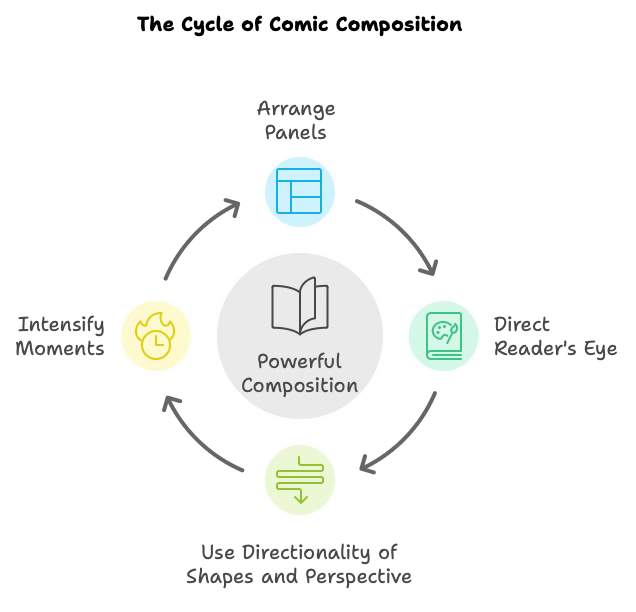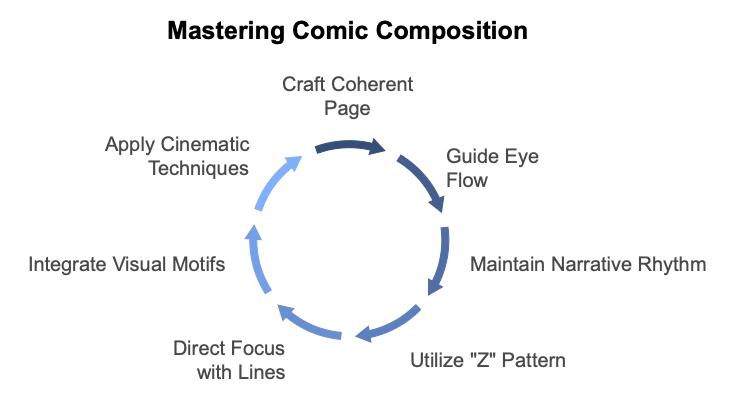Mastering Comic Composition: Lead Your Reader's Eye Through Every Story Beat
Comic composition lets you guide, reveal, and intensify. Uncover techniques for controlling reader flow and pacing, making your story impossible to put down.
Composition is more than arranging panels—it's a skill that gives you control over how readers experience every beat of your story. Slapping down a cool image may be fun, but great composition is deliberate in directing the reader's eye, shaping the flow, and intensifying each moment. Nail composition, and you draw them deeper into the narrative.
Critical Elements of Effective Comic Composition
Gestalt Page Read
Start with the big picture: each page should feel cohesive at a glance, setting the tone and mood before readers dig into individual panels.
Panel Flow
Guide the reader's eye through each panel with purpose. Use contrast, character gazes, and layout to create a natural sequence so each moment flows smoothly to the next.
Page Transitions
Think of each page as part of the narrative rhythm. Cliffhangers and thoughtful transitions between pages keep readers turning, primed for what's next without losing the story's momentum.
The "Z" Pattern
Embrace the left-to-right, top-to-bottom "Z" flow. This natural reading pattern anchors the composition, helping readers' gaze slip seamlessly through each page.
Leading Lines and Perspective
Use geometry, lines, and perspective to direct focus within each panel and across the page. Leading lines and visual pathways point readers toward key elements, guiding their attention intuitively. They're visual elements that guide the viewer's eye toward a focal point in an image. In comics, they can be anything from the direction of a character's gaze to architectural lines or shadows. These lines help direct attention to important details, guiding the reader's eye through the panel and page.
Visual Motifs and Symbolism
Integrate recurring imagery or subtle symbols to add depth and cohesion to the story. These visual echoes connect scenes and reinforce themes without interrupting the flow. It's a subtle thing, but it can be catnip for attentive readers.
Cinematic Techniques
Borrow from film with techniques like "nose room" and constantly shifting perspective to create a dynamic, immersive experience. “Nose” room (also called “looking” room) is the space that gets activated (visually charged) in front of the main character and the edge of the frame. Shot design is a big deal, and in comics, as in film, an active camera creates an active read. Close-ups create intimacy, wide shots add context, and character gazes help direct the reader's eye to the next moment. If you’re at a loss, pick a different shot at random. In comics, changing your shots makes the sequence more dynamic. Even arbitrarily different shots beat identical shots.
Quick Tips for Better Composition
Spot Blacks and Tonal Shifts: High contrast or gray tones can highlight key moments and guide the eye within each panel.
Color as Focus: When you upgrade from black and white to color for your comic, you can use specific hues to tie scenes together or set a specific mood. When the colors shift, they can indicate an emotional change or point to a new scene. They can also emphasize crucial details.
Reinforce with Recurrence: Repeated symbols or themes add a subtle layer of storytelling that keeps readers engaged. Advanced stuff, but if you're ready for more nuanced and subtle visuals, this is powerful.
Perspective Creates Emotion: Vary your shots—close for drama, wide for context. A character's gaze can nudge readers to the next panel.
By mastering composition, you're not just arranging images—you're crafting an immersive visual journey. Keep experimenting with these techniques; you'll soon lead readers through every story beat with intention and control.
Intention and execution are traits of powerful artists. We can all be better artists, more thoughtful, and more skilled with each page under our belts. It's a choice.
Charles Merritt Houghton
9 November 2024







